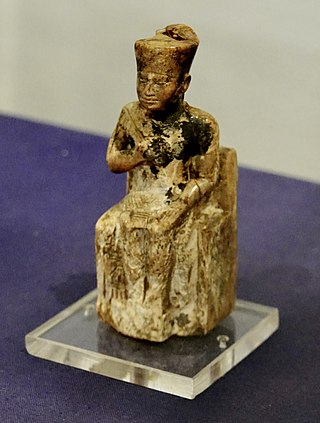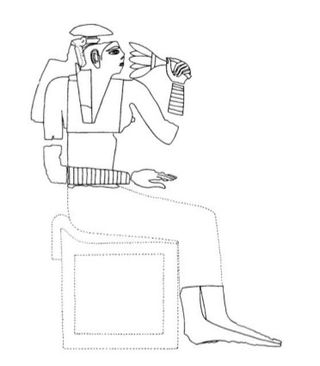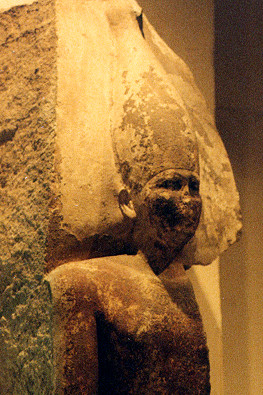
Khufu or Cheops was an ancient Egyptian monarch who was the second pharaoh of the Fourth Dynasty, in the first half of the Old Kingdom period. Khufu succeeded his father Sneferu as king. He is generally accepted as having commissioned the Great Pyramid of Giza, one of the Seven Wonders of the Ancient World, but many other aspects of his reign are poorly documented.

Menkaure, was a pharaoh of the Fourth Dynasty of Egypt during the Old Kingdom, who is well known under his Hellenized names Mykerinos and Menkheres. According to Manetho, he was the throne successor of king Bikheris, but according to archaeological evidence, he was almost certainly the successor of Khafre. Africanus reports as rulers of the fourth dynasty Sôris, Suphis I, Suphis II, Mencherês (=Menkaure), Ratoisês, Bicheris, Sebercherês, and Thamphthis in this order. Menkaure became famous for his tomb, the Pyramid of Menkaure, at Giza and his statue triads, showing the king together with his wives Rekhetre and Khamerernebty and with various deities.

Khafre was an ancient Egyptian pharaoh of the Fourth Dynasty during the Old Kingdom. He was the son of Khufu and the successor of Djedefre.

Hetepheres II was a Queen of Ancient Egypt during the 4th Dynasty.

The Fourth Dynasty of ancient Egypt is characterized as a "golden age" of the Old Kingdom of Egypt. Dynasty IV lasted from c. 2613 to 2494 BC. It was a time of peace and prosperity as well as one during which trade with other countries is documented.

Hetepheres I was a queen of Egypt during the Fourth Dynasty of Egypt who was a wife of one king, the mother of the next king, the grandmother of two more kings, and the figure who tied together two dynasties.

Ankhhaf was an Egyptian prince and served as an overseer during the reign of the Pharaoh Khufu, who is thought to have been Ankhhaf's half-brother. One of Ankhaf's titles is also as a vizier, but it is unknown which pharaoh he would have held this title under. He lived during Egypt's 4th Dynasty.

Sneferu, well known under his Hellenized name Soris, was the founding pharaoh of the Fourth Dynasty of Egypt during the Old Kingdom. Estimates of his reign vary, with for instance The Oxford History of Ancient Egypt suggesting a reign from around 2613 to 2589 BC, a reign of 24 years, while Rolf Krauss suggests a 30-year reign, and Rainer Stadelmann a 48-year reign. He built at least three pyramids that survive to this day and introduced major innovations in the design and construction of pyramids.

Queen Meresankh III was the daughter of Hetepheres II and Prince Kawab and a granddaughter of the Egyptian pharaoh Khufu. She was the wife of King Khafre.
Minkhaf I was an ancient Egyptian prince of the 4th Dynasty. He was a son of Pharaoh Khufu, half-brother of Pharaoh Djedefre and elder brother of Pharaoh Khafre. His mother may have been Queen Henutsen. Minkhaf had a wife and at least one son, but their names are not known. Minkhaf served as vizier possibly under Khufu or Khafre.
Meritites I was an ancient Egyptian queen of the 4th Dynasty. Her name means "Beloved of her Father". Several of her titles are known from a stela found at Giza. She was buried in the middle Queen’s Pyramid in Giza.

Henutsen is the name of an ancient Egyptian queen consort who lived and ruled during the 4th dynasty of the Old Kingdom Period. She was the second or third wife of pharaoh Khufu and most possibly buried at Giza.
Meresankh I was an ancient Egyptian kingʻs wife and the mother of King Sneferu. She may have been a wife of King Huni, the last king of the 3rd Dynasty.

Mindjedef was a Prince of ancient Egypt, who lived during the 4th Dynasty. His name means "Enduring Like Min". Min is an Egyptian fertility god.

Meresankh II was a Queen of Egypt who lived during 4th Dynasty.
Nebty-tepites was a Princess of ancient Egypt. She is mentioned in the tomb of her mother, Meresankh II.

Horbaef was an ancient Egyptian prince of the 4th Dynasty. His title was "King’s son".
Hemetre (Hemetra) was an ancient Egyptian royal woman of the Fourth Dynasty. Hemetre may have been a daughter or granddaughter of Khafre. She did not hold the title king's wife and may have even married a non-royal. She is mainly known from her tomb, which is located in the central field of Giza. Her name honors the god Ra.
Djaty I was an ancient Egyptian prince during the 4th Dynasty. He was an overseer of a royal expedition.

Women in ancient Egypt had some special rights other women did not have in other comparable societies. They could own property and were, at court, legally equal to men. However, Ancient Egypt was a patriarchal society dominated by men. Only a few women are known to have important positions in administration, though there were female rulers and even female pharaohs. Women at the royal court gained their positions by relationship to male kings.
This page is based on this
Wikipedia article Text is available under the
CC BY-SA 4.0 license; additional terms may apply.
Images, videos and audio are available under their respective licenses.












